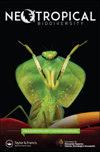Macroinvertebrates’ response to different land use in lowland streams from Uruguay: use of artificial substrates for biomonitoring
IF 0.8
Q4 ECOLOGY
引用次数: 3
Abstract
ABSTRACT The use of macroinvertebrates as indicators of water quality is an effective and low-cost tool, which is widely implemented in biomonitoring programmes. Certain taxa are characteristic of impaired watercourses (e.g. Oligochaeta, Chironomidae and Amphipoda), while others are characteristic of good-quality watercourses (e.g. Ephemeroptera, Plecoptera and Trichoptera; EPT). In this work, we evaluated the response of the macroinvertebrate assemblages to different land uses. For this purpose, artificial substrate colonization experiments were conducted in streams including urban (U, n = 3), intensive agriculture and dairy production (AD, n = 4) and extensive cattle ranching (CR, n = 4) land uses. Because in Uruguay pristine ecosystems are practically non-existent and streams of low order streams associated with extensive cattle production represent the lowest deterioration water quality condition, CR sites were used as control reference streams. Physicochemical water parameters were measured. For macroinvertebrate sampling, 10 artificial substrates were installed in each stream. A total of 110 artificial substrates were analysed. Each sample/site consisted of a plastic mesh bag of 1.2 cm opening, which were filled with 160 cm3 (including 73.3 ± 5.8 cm3 interstitial water) of stones sieved between 1.3 and 1.5 cm. During the summer of 2018 (February), devices were left in streams for 15 days for communities to colonize them. U and AD land use represented the stressors with the highest impact on the attributes and composition of the macroinvertebrate communities. Abundance of EPT was higher in CR, meanwhile Caenogastropoda dominated in AD, and Amphipoda in U sites. Macroinvertebrate groups to order level classification were able to effectively discriminate between different land uses. The use of artificial substrate also demonstrated to be efficient method for monitoring macroinvertebrate community. We did not find a correlation between the physicochemical water parameters and the macroinvertebrate community. In this context, we propose a rapid and cost-effective biomonitoring approach, capable of estimating the degree of impact of different land uses.乌拉圭低地溪流中大型无脊椎动物对不同土地利用的反应:使用人工基质进行生物监测
摘要利用大型无脊椎动物作为水质指标是一种有效且低成本的工具,在生物监测计划中得到了广泛实施。某些分类群以受损水道为特征(如寡毛目、摇蚊科和两栖纲),而另一些分类群则以优质水道为特征。在这项工作中,我们评估了大型无脊椎动物群落对不同土地利用的反应。为此,在溪流中进行了人工基质定殖实验,包括城市(U,n=3)、集约农业和乳制品生产(AD,n=4)以及广泛的养牛场(CR,n=4)土地利用。由于乌拉圭的原始生态系统几乎不存在,与大量养牛相关的低阶溪流是水质恶化程度最低的河流,因此CR站点被用作对照参考溪流。测定了水的理化参数。对于大型无脊椎动物采样,在每条溪流中安装了10个人工基质。共分析了110个人工基质。每个样本/地点由一个开口1.2厘米的塑料网袋组成,里面装满了160立方厘米(包括73.3±5.8立方厘米的间隙水)的石头,这些石头在1.3到1.5厘米之间筛分。在2018年夏天(2月),设备在溪流中放置了15天,供社区进行定植。U和AD土地利用是对大型无脊椎动物群落属性和组成影响最大的压力源。CR位点的EPT丰度较高,AD位点以软体动物为主,U位点以两栖动物为主。大型无脊椎动物群体能够有效地区分不同的土地用途。人工基质的使用也被证明是监测大型无脊椎动物群落的有效方法。我们没有发现理化水参数与大型无脊椎动物群落之间的相关性。在这种情况下,我们提出了一种快速且具有成本效益的生物监测方法,能够估计不同土地利用的影响程度。
本文章由计算机程序翻译,如有差异,请以英文原文为准。
求助全文
约1分钟内获得全文
求助全文
来源期刊

Neotropical Biodiversity
Environmental Science-Ecology
CiteScore
1.80
自引率
0.00%
发文量
39
审稿时长
24 weeks
 求助内容:
求助内容: 应助结果提醒方式:
应助结果提醒方式:


